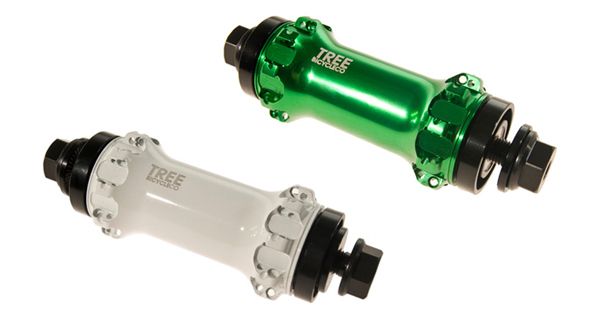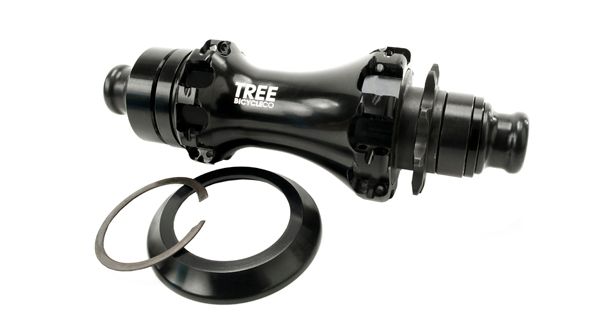
I’m sure by now you have taken notice to Tree‘s different level of products. There’s a lot of products out there, and it tends to get a little painful seeing the same products with different brand names on them. Sure, there’s only so many ways to make a pivotal post, seat or even a set of bars, but there’s always room for improvement and trying different unconventional routes to creating a new product. Sam, the owner of Tree, is one of those guys who is unconventional and that’s a good thing. The Straight Pull hubs are a prime example of doing things a little different and having it work out great. I figured it would be cool to take an indepth look at their Straight Pull hubs, so I shot Tree some questions about them. Take a look and let them know what you think in the comments. If you are looking to get a set, you better act fast since these things sell fast…
Name: Nathan Parker
Role and Years at Tree:
I am a Rider/Media Coordinator/TM for Tree. 5 years as a rider, A little over a year for everything else.
Years riding:
15 or 16, It depends, I always rode but my first “trick bike” was a flat black Diamondback Venom in ’96, but I count the summer of ’97 as the first year if I have to count.
This time around we are talking about the Tree Straight Pull hubs. These have been available for a while now, but seem to be getting quite a bit of attention and having trouble staying in stock.
When was the original idea for the hub brought to the table? Were there any hubs that influenced the design of the hub?
The first concept for a Tree hub was drawn up in 1999, the Straight pull hubs followed in around 2005 – 2006. There were no specific hubs that influenced the design, but it was technology that was being used in the road bike and mountain bike industry, and a little in the BMX industry but it wasn’t very successful. During early design stages of the Tree Straight pull hub Sam picked a Brunn straight pull hub, which is a German company, to just run one to test the advantages. The Brunn hub was not the base for the Tree hub though, other than using straight pull spokes they are not very similar at all.


You guys went with a straight pull design among many of the special features. How long did it take to get the idea into a CAD drawing? What kinds of changes did you have to make from the original idea to the drawing?
The process for the hubs started like most thing with Tree, Sam kind of gets ideas for bike parts popping into his head, and then he usually sketches them out on paper and lets it sit for a while then comes back to it with any changes and then he draws it in the computer. The hubs skipped paper and Sam just started working on it in the computer right away. It took a long time to draw these hubs because other hubs using the straight pull spokes were 32 spoke hubs, so it took some time to figure how to arrange the spokes and the cross pattern that would be necessary for a 36 hole version.
Once it was all set, how long did it take to get a prototype made? Where do you guys go to have your hubs made?
It took a long time to get a prototype made, way longer than it ever should have, a year and a half from our American manufacturer. We now have our hubs made in Taiwan by Chosen, the highest quality hub manufacturer there is, and it took a month and a half to receive the prototype from them.
How long did testing on the hub go for? Did you guys run into any sort of problems or issues with the design that required some changes?
It unintentionally was tested for two years, just because we were having trouble with our manufacturer at the time, but they were pretty good. The only problems we had were a slight wobble side to side and our socket drive bolts would blow out the sides sometimes. We tightened up some axle tolerances, added a little material to the bolt heads, and also added a little wall thickness to the axle butts for good measure.
The production hubs have been available for quite a while now. How has the reaction been from the people riding the hubs? Have you guys seen many warranty issues?
The front hubs have been available for two years and the rear hubs just came out a few months ago and they have been selling out so fast, but we have another shipment coming real soon. So far the reaction has been good the spoke design makes a wheel noticeably stiffer, and it rolls fast and long. We haven’t had any warranty problems yet, the worst is riders not running the hub guard and damaging the flanges, sometimes someone will get the plastic guard or snap ring for the guard snagged and will need a new one.

Alright, so let’s first take a look at the front hub. What are the specs (weight, colors, materials, etc.) and some of the special features of the hub?
The hub is 8.1 ounces, has a 7075 female axle design which is really strong and light, it has a special inner design that allows for the bearings to never have side load no matter how tight you crank down the bolts., it uses straight pull spokes, and comes in black and silver now, but there are still a few purple, red, blue, green, and white ones out there and we will be bringing back more color options soon.
How about the rear hub? What are some of the specs (weight, colors, materials, etc.) and features of that hub? The driver system looks to be different than most of the others on the market.
The production rear hub weighs 14 ounces with the micro guard, and we have a few variations of prototypes with 7075 hardware, axle, and driver that weigh 9.1 – 10.7 ounces that we are testing out now. It has a hollow chromoly female axle and bolts, and the driver uses a ceramic plane bearing. Instead of having a bearing in the driver that is small and eventually blow up, our driver uses a strong ring of ceramic that spins smoothly on the axle for a longer lasting driver. The rear hub also features the special internal design to eliminate side load. The flanges are two different diameters but because it uses straight pull spokes we were able to machine them in a way that the drive side flange is slightly thicker the direction the spokes go in which allows for the same length of spokes to be used for both sizes and aligns your rim perfectly so that it is not dished to the left or the right. Both the front and the rear hubs are designed so that once you start the first spoke in the correct hole and meet it to the correct hole in the rim the indexing of the flanges prevents you from being able to lace your wheel in a way that blocks your valve stem. The rear hub comes in silver or black, RHD or LHD, 9 or 10 tooth drivers.

Using the straight pull design seems to be a regularly passed on design among the rest of the brands making wheels. What made you guys want to go with that? Was it just to do something different, or were there benefits there that nobody else was utilizing?
We don’t really do anything just to be different, with all tree products we try to design them to be an improvement in function, form, strength , and weight. The straight pull spoke is better than a traditional J bend spoke. The wheel is stiffer and stronger with this design, the spoke is stronger because it doesn’t have the sharp bend at the bottom, and a good side effect is that the wheel is incredibly easy to lace, the spokes easily go directly to the proper hole on the rim from the hub.
Where can you pick up a set of hubs and for how much?
You can pick up some Tree hubs at any shop that carries Tree, Empire, Dan’s Comp, or other mail order companies that deal in Tree goods, or from us directly.
Do you guys offer a warranty on the hubs?
If you have a problem with your hubs or any Tree part, just give us a call or write us an email. We will check it out and will offer a warranty or replacement parts at a reduced price depending on the situation.

Who should shops and distributors contact to get the Straight Pull hubs in their shops and warehouses?
Distros should contact Tree for an application and shops can contact Blackout in the US, or the Tree distributor for their country, and anyone can always contact us directly.
Who should somebody contact if they have questions about the hub?
Questions about the hub should go to me at info@treebicycleco.com we really enjoy being in tough with the riders so don’t hesitate to write if you have any questions.
To find out more about Tree products, hit their website at TreeBicycleCo.com and have a look around.
